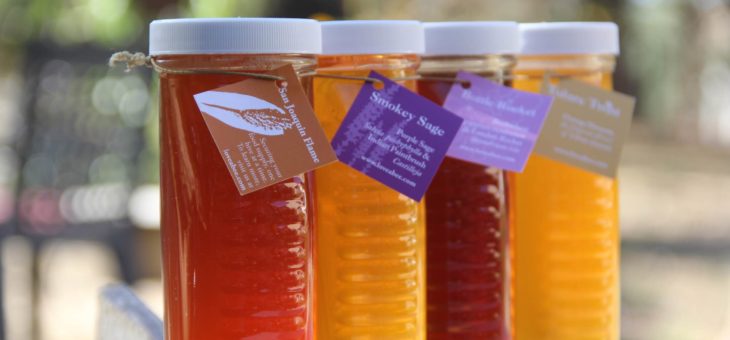
As the co-founder and CEO of Love a Bee, Louise Derrick collaborates with beekeepers to source 100% raw, unpasteurized and unadulterated honey from California. We got the full story in this interview with Louise. Stop by for our anniversary celebration Saturday, August 20th to meet Louise and taste Love a Bee honey.
Love a Bee grew out of an MBA design project, can you tell us more about that?
I came to California in 2011 to attend a specialized MBA program in Design Strategy at California College of the Arts. It was one of several programs of its type in the United States at the time. I commuted monthly from South Carolina for almost a year. In the second year, I moved here so that I could be closer to the projects and people with whom I was working.
My final thesis/venture project was to create a business, business model and pitch the idea. I had been really interested in bees and their importance to our survival. After realizing that their numbers were terrifyingly low due to a phenomena called Colony Collapse Disorder which involves a number of complex and interlinked issues such as Pesticide use, varroa mite infestations, monoculture, and lack of forage diversity- that all contribute to the weakened bee population, I decided to address the aspect that I felt I could affect the most—lack of forage diversity. The resulting business was Love A Bee.
Tell us more about how Love a Bee honey is tied directly to the land.
I work with beekeepers who maintain a wide variety of forage or set their bees on land that has varied and unique forage. I work with these beekeepers, educate myself about the forage in the area, employ sensory analysis (for example, Orange Blossom honey is more floral that citrus) and translate that into a unique taste profile that reflects the forage source(s). It is a wonderful way to educate and learn about the different flora and fauna that make California unique and it is a true unencumbered taste of the land.
Do you keep your own bees as well partnering with beekeepers?
I grew up on a 250 acre farm in South Carolina. My grand scheme was to put bees there but I am still learning and working with beekeepers here in Northern California. I do have several of my own hives but the majority of my work is assisting/learning from seasoned beekeepers and passing that knowledge on to consumers. I will launch an Adopt A Hive program in the coming month. That way, I can offer the benefits of having bees and or honey to landowners here in Northern California and elsewhere.
What factors influence the color and textures of honey?
The color and texture of honey is influenced by the floral source, weather and climate. Honey can vary from almost transparent to black.
Do you have any unusual ways to use honey?
Ha! Honey is magical to me. It can be used on and in almost anything. I use it as a glaze, as a sweetener, as a simply syrup, on pancakes, in my tea, in my coffee, on my skin (honey never spoils). It is often used on burns. I share all kinds of ways to use honey on the Honey for Health section of my website.
Louise shares lots of recipes online including one for Lamb with Sweet & Sour Honey Glaze, which she developed especially for us!

Congrats to you on your very important venture. I am an avid believer in manuka honey for its numerous health benefits. It is expensive, hard to find and mostly imported from New Zealand. Do you see your honey having similar benefits? Thannks